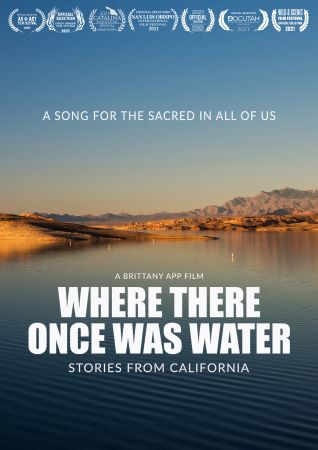
Where There Once Was Water 2021
Distributed by epf media, 324 S. Beverly Drive, PMB 437, Beverly Hills, CA 90212; 310-839-1500
Produced by Brittany App
Directed by Brittany App
Streaming, 74 mins
College - General Adult
Conservation; Ecology; Water
Date Entered: 06/01/2023
Reviewed by Erica Swenson Danowitz, Chat Reference Librarian – Pennsylvania’s Chat with a Librarian (CWAL), Independent Contractor at Hosting Solutions & Library Consulting (HSLC); Retired Professor/Reference Librarian, Delaware County Community CollegeAt the onset of this film the director, who also serves as the narrator, states, “this is a love story” about water. Where There Once Was Water focuses on California and other regions of the American Southwest. Through interviews with authors, environmentalists, urban farmers, and leaders in the non-profit conservation sector, the filmmakers present two stories, the old way of managing/obtaining water and newer practices. Older ways included cities’ (such as Los Angeles) importation of water from other regions and dam construction. These costly methods moved water around unnaturally and created more problems than solutions. The film demonstrates how newer techniques help capture water without significantly altering habitats or landscapes which the older, twentieth century methods had regrettably done. Twenty-first century methods include studying watersheds, recycling water, monitoring soils, using permaculture, and employing keystone species such as trees or beavers to ameliorate ecosystems and watersheds. According to the film these innovative modern practices assist in continuing a healthy, environmentally friendly water cycle. One learns that 70% of water is used to grow food but larger, commercial farms inconceivably tend to not utilize these newer methods. Most cities also do not have processes in place to capture or store water outside of using antiquated, unnatural approaches.
Where There Once Was Water emphasizes that water is life but that most individuals take water for granted and often use it unnecessarily or in wasteful ways. The film frequently underscores how water is not limitless. It demonstrates how millions of people have no easy access to water by including scenes with Navajo Nation members who must have water trucked to their homes. Viewers are asked to consider what life would look like without water to really reflect on its value and importance. One commentator notes that anyone who has ever had to carry or haul water, better appreciates it, and understands its essential value. Some of the film’s participants discuss how water should be considered a fundamental human right, but this right is not currently codified anywhere.
This film features gorgeous scenery which often includes rainbows and footage of rivers teeming with fish or other wildlife. It captures the lived experiences of various individuals who recognize the importance of water in their daily lives and to their existence including, Native Americans, cattle farmers, scientists, vintners, and waterkeepers. Although it ends on a positive note, this is a sobering documentary. It provides statistics such as, by 2025 60% of the world’s land masses will face water scarcity. Americans living in 40 out of the 50 states will also face this crisis based on many factors including urbanization, pollution, flawed water management techniques, and climate change.
This documentary is available in DVD or DSL formats and can include public performance rights. Where There Once Was Water is recommended for advanced high school classes and college courses such as biology, ecology, engineering, or geology. As a teaching tool it offers a powerful message that allows viewers to recognize water’s value. This precious resource makes all life on earth possible and ensures our survival.
Published and licensed under the Creative Commons Attribution 4.0 license. Anyone can use these reviews, so long as they comply with the terms of the license.